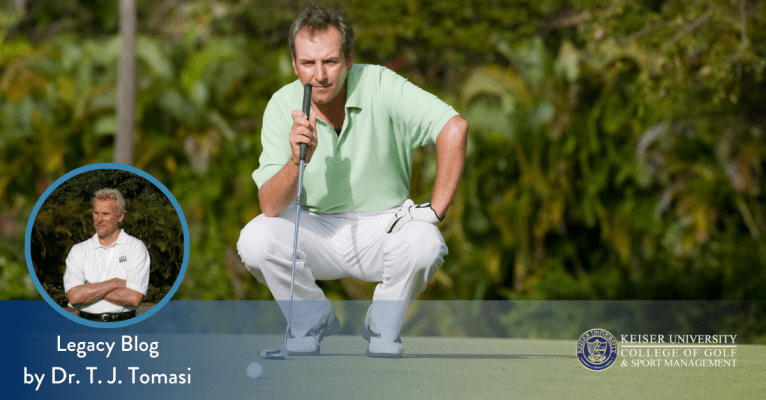Golf Mental Exercises: Imaging Helps Protect Golf Muscle

A Legacy Post by Keiser University College of Golf Senior Faculty and Director of Research Dr. T. J. Tomasi (1940-2023)
I’ve given more than 50,000 golf lessons, and my experience tells me that most golfers don’t have a lot of time to work out and/or don’t like to – so they seldom visit the gym. Either way, this lack of a structured workout presents a real problem, especially as you age. For this reason, I’m always on the lookout for effective prophylactics my students can use, and I’m now going to offer to you the ultimate intervention: Simply imaging your workout protects your golf muscles from atrophy. After you read this, you’ll have to agree that your workout can’t get any easier than just thinking about it!
Mental Exercises for Golf
Golf mental exercises are essential tools for golfers aiming to enhance their performance on the course. These exercises focus on developing mental resilience, concentration, and focus, which are crucial aspects of the game. Through techniques such as visualization, mindfulness, and positive self-talk, golfers can train their minds to stay calm under pressure, maintain focus throughout the round, and overcome challenges with confidence. By incorporating mental exercises into their training regimen, golfers can sharpen their mental skills, leading to improved consistency, decision-making, and overall performance on the golf course.
Golf Mental Imagery
Golf mental imagery involves creating vivid mental representations of specific golf shots, scenarios, or situations without physically executing them. This technique allows golfers to mentally rehearse their shots, visualize successful outcomes, and build confidence in their abilities. The Ohio State University study mentioned above, conducted by Brian Clark, Ph.D., investigated the effects of mental imagery on golf performance. His study found that golfers who incorporated mental imagery techniques into their practice routines experienced significant improvements in their shot accuracy, distance, and overall performance. Additionally, participants reported enhanced levels of focus, concentration, and self-confidence during their rounds. The study’s findings underscore the importance of incorporating mental imagery into golfers’ training routines to optimize their performance and achieve consistent results on the course. Overall, mental imagery serves as a valuable tool for golfers seeking to sharpen their mental skills, elevate their game, and achieve peak performance levels in competitive golf environments.
The Research
A recent study at Ohio University by Brian Clark, Ph.D., a professor of neuroscience, explains the principle: “What our study suggests is that imagery exercises are a valuable tool to prevent or slow muscles from becoming weaker when a health problem limits or restricts a person’s mobility. The most impactful finding is … the critical importance of the brain in regulating both muscle strength and growth.”
Here’s how it works: To give your muscles a mental workout, first relax through deep, regular breathing for about 60 seconds, then close your eyes and begin to perform in your mind a preselected exercise – such as a dumbbell curl. See your arm bent at the elbow, and the weight rising as your biceps muscle begins to bulge — and you can actually move your arm as you match the proper motion. Do three sets of 10 repetitions just as you would in an actual exercise. The most famous bodybuilder of all time – Arnold Schwarzenegger – used imagery on every lift, so we know it works. While Clark and his group focused on patients who had injuries, there’s no reason golfers can’t use the technique to keep their golf muscles in shape while away from the gym and the golf course.
Takeaway
You can make changes in the physical pathways devoted to a particular skill by using your brain’s power to create clear, distinct, and glitchless mental pictures that are so real that they fool the body into thinking you are actually working out. Said another way, you can “be there and do that” without having “been there and done that.”
That’s the good news – the bad news is you still have to do the physical parts of your exercise regime – aka ‘no pain, no gain.’
Learn more!
Want more tips? If you want to take your game to the next level, contact our team at Keiser University’s College of Golf & Sport Management today. With our dedication and experience, we can elevate your game to new heights together. Give us a call today at 888-355-4465.














